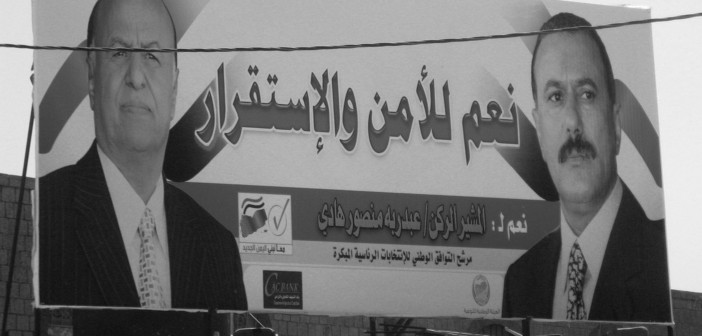When the ‘Arab Spring’ spread to Yemen, some observers thought that the regime would collapse. The Western media claimed that democracy was coming. But the former President Saleh handed power over to his colleague, the new President Hadi. The bottom line is that everything remains in the country of Sheba.
Hope wanes after the National Dialogue in Yemen…
In 2011 the Old Jewish Quarter of Sana’a reverberated with the sound of gunfire. The quarter’s main street became the de facto no-man’s-land between the warring sides. On the eastern side, near Bab al-Balagha, sat al-Firqa, the army division led by Ali Mohsin, which defected from the regular Yemeni army after the “Day of Dignity”, 18 March 2011, when over 50 protestors[1] were killed in “Change Square”. At the other end of the street in Qaa‘ al-‘Ulufi was the army itself, dug-in with sandbagged positions, tanks, and water cannons. Around the neighborhood, snipers nestled into a hospital, electricity station, university and minaret, shooting civilians and soldiers.
During these dark days—literally, without electricity because of attacks on power stations—dialogue among Yemenis was about fear, escalation and the increasing difficulty of daily existence. Yet Yemen ostensibly fared better than the region, avoiding an ugly civil war and sidestepping a crippling political stalemate and subsequent retaliation. The country embraced a transitional agreement brokered by the Gulf Cooperation Council to end the impasse.
Initial euphoria accompanied this agreement, the Gulf Initiative, which mandated symbolic one-party elections and the thornier process of national dialogue. Such actions engendered hope among citizens for a peaceful, lasting resolution—not only to the country’s political crisis, but to its myriad problems. But specific ideas were few. When observers of early presidential elections in 2012 asked citizens at polling centers on Election Day what would happen after the elections, the response was uniformly, ‘once we vote Saleh [the former President]out of office, we’ll be able to solve the problems.’[2] Whether such optimism was justified is now moot: the political, economic and security situations have stagnated and deteriorated to the point that, once again, many Yemenis despair about their country’s future.
The GCC Initiative was an odd way for any democracy to end a political impasse: citizens did not vote for it; the chamber of representatives in Parliament did not ratify it; and the agreement specifically states that it supersedes all other agreements and is not reviewable by any state institution.
The UN Human Rights chief, Navi Pillay, warned in fact that it might violate international law.[3] Regardless, because of it, peaceful pro forma elections ushered in President Abd Rabu Mansour Hadi, a compromise candidate whom few ever suspected would hold the government’s top office, but who has been surprisingly adept at shuffling top military leadership while avoiding internecine conflicts.
Despite its democratic deficit, the Gulf Initiative represented a departure from Yemen’s normal political scene, “the politics of dysfunction”[4]: a cycle wherein the Yemeni government preys on security fears in the international community by encouraging a destabilized security environment in order to solicit foreign money, which in turn funds corrupt political patronage networks that ultimately destabilize the security situation.
As a condition of the Gulf Initiative, the country began the National Dialogue Conference, or NDC, on 18 March 2013, the second commemoration of the Day of Dignity. The primary goal of the NDC was to discuss the nine most serious issues threatening the republic’s fragile political unity: transitional justice, the southern issue, Saada (i.e. the Houthi rebel movement), state building, good governance, military/security, rights/freedoms, development, and special entities.
As a process, the NDC was open and straightforward, broadcast on media throughout the country and inviting 565 representatives from all facets of Yemeni society to debate and design the country’s future. Ongoing protests, both on the streets and inside the NDC, underscored the freedom Yemenis have to voice discontent publicly, a rarity in the region. More specifically, in an unprecedented move, on 21 August 2013 the government officially apologized both to the Houthi rebel movement for ten years of seasonal warfare, and to southern Yemenis for misappropriation of land in the south.
Despite a six-month extension and laboring more than a year over key questions of governance and grievance, there has been scant concrete progress from the NDC. Political actors and citizens alike have now grown restless, and old patterns are emerging. Serious incidents of political violence, lack of faith in the process among ordinary citizens and an unchecked rise in sectarian violence have brought the country dangerously close to the edge of the abyss it deftly managed to avoid three years ago.
The major result of the NDC was agreement on the basic form of new governance for the country, federalism; how power and resources will be shared is still not clear. The hasty rhetorical declaration bringing it to a close on 25 January of this year left many issues open and did little to inspire confidence among citizens. More alarmingly, members and observers of the NDC seem unable to publicly articulate accomplishments of the Dialogue.[5] The President’s recent announcement of a constitutional committee, which would last ‘not more than one year’, angered Yemenis who had hoped to hold elections early in 2014, as envisioned by the GCC.
So hope has waned for a definitive, peaceful resolution to the country’s worsening crises.
Security has deteriorated substantially in recent months, with political violence escalating, including assassinations, the use of IEDs and car bombs. Violent tribal disputes have overrun certain Sana’ani streets, and sabotage of public services, seen as a legitimate means of revenging political grievances, plunges the capital into regular bouts of darkness.
The humanitarian situation remains dire, with roughly half of Yemenis living below the poverty line of $2/day.[6] Yemen has emerged as a brutal transit country for migrant labor from the Horn of Africa; roughly 20,000 refugees from the Horn currently sit stranded in the Yemeni border city of al-Haradh alone, caught between a heavily fortified and closed Saudi border and Yemeni attempts to extort and torture.[7] These numbers do not include UNHCR’s estimate of over half a million internally displaced Yemenis as of 2012.[8]
Armed groups heighten the political calculus even more. The Houthis, branded an extremist Shiite group by the Yemeni government and suspected of receiving Iranian support, are accused of wanting to restore a Zaydi Imamate in Yemen.
Their extremist slogan, ‘Death to America, death to Israel, curses upon the Jews, and victory to Islam’ is ubiquitous, and their presence is popular in many areas of the country. They now regularly battle Salafist militants and government forces north of the capital with fatal consequences.
These issues, along with dwindling natural resources like oil and water, debilitating poverty and an estimated average illiteracy rate of approximately 20% among men and 55% among women[9] leave observers and Yemenis alike wondering how Yemeni leadership will pull the country out of an impending vortex of violence and political discord that has already begun to dismantle everything around it, including any viable vision of a peaceful, prosperous future.
[1] The exact number is unknown, with accounts ranging from 45-75. For an excellent documentary on these events, see Lesyat lil Karama Jidran (“Karama Has No Walls”), the only Oscar-nominated Yemeni film to date (Sara Ishaq, dir., 2012)
[2] Personal communications with author [21 February 2012].
[3] http://www.aljazeera.com/indepth/features/2013/06/2013624103647439263.html (last accessed 14 April 2014).
[4] Cf. Phillips, Sara, Yemen and the Politics of Permanent Crisis (New York: Routledge, 2011).
[5] Public Discussion on the NDC, American Institute for Yemeni Studies, Sana’a, Yemen, 6 March 2014.
[6] Boucek, Christopher and Ottaway, Marina, eds. Yemen on the Brink. Washington D.C.: Carnegie Endowment for International Peace, 2010, 10.
[7] BBC documentary Yemen: The Most Dangerous Journey on Earth (2013): http://www.bbc.co.uk/programmes/b037lsmw [14 April 2014].
[8] That number was projected to fall by the end of 2013, but it will remain in the hundreds of thousands http://www.unhcr.org/pages/49e486ba6.html [14 April 2014].
[9] UNESCO Institute for Statistics, “UIS Statistics in Brief: Education (all levels) profile—Yemen.” http://stats.uis.unesco.org/unesco/TableViewer/document.aspx?ReportId=121&IF_Language=eng&BR_Country=8850&BR_Region=40525 [14 April 2014].




1 Comment
Thanks a lot for this article!!!!!!
Newspaper in Europe said : Yemen is democratic;
Of course, it isn’t !!!